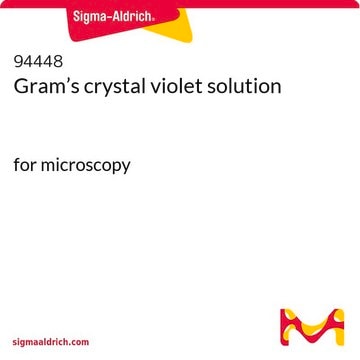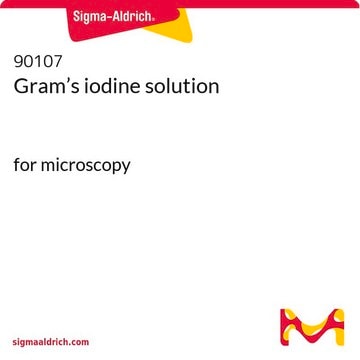Products with a high water content away from "the generally known reaction partners of water." This caution is due to water's potential to react violently with numerous substances, resulting in the development of gases and the ignition of released Hydrogen, posing a risk of explosion.
Additionally, various substances or mixtures can explode upon the addition of a drop of water, with details of these reactions provided in the safety data sheets of the specific reaction partners. Substance groups that react violently with water include Alkaline earth metals, Alkaline metals, Aluminum alkalines, Metallic or Nonmetallic hydrides, Metallic or Nonmetallic oxides, Acid anhydrides, and Acid chlorides.
Select a Size
Select a Size
About This Item
Recommended Products
form
aqueous solution
Quality Level
concentration
1%
technique(s)
microbe id | staining: suitable
color
deep violet, purple
Amax
0.36-0.44 at 589-594 nm
application(s)
diagnostic assay manufacturing
hematology
histology
storage temp.
room temp
SMILES string
[Cl-].CN(C)c1ccc(cc1)\C(c2ccc(cc2)N(C)C)=C3/C=C\C(C=C3)=[N+](/C)C
InChI
1S/C25H30N3.ClH/c1-26(2)22-13-7-19(8-14-22)25(20-9-15-23(16-10-20)27(3)4)21-11-17-24(18-12-21)28(5)6;/h7-18H,1-6H3;1H/q+1;/p-1
InChI key
ZXJXZNDDNMQXFV-UHFFFAOYSA-M
Looking for similar products? Visit Product Comparison Guide
General description
It stains the fatty portions of sebaceous sweat a deep purple color. Crystal violet can also be used to enhance bloody fingerprints. This dye is harmful if inhaled, swallowed or absorbed through skin, contact may cause cancer, severe eye irritation in human beings.[2]
Application
- Crystal violet is commonly used in Gram staining for the classification of bacteria.[3]
- It has also been used to detect bacterial adherence to biomedical polymers and to stain DNA in mammalian tissues in Giemsa staining.
- It has been successfully used to develop a counterion-staining method to detect DNA in agarose gel electrophoresis.[4]
- Its antimicrobial properties have facilitated its use in the treatment of oral candidiasis, skin infections, and methicillin-resistant Staphylococcus aureus.[1]
- It has been used as a stain in cell proliferation assays, migration assays, and Boyden chamber assay.[5][6][7]
Biochem/physiol Actions
Principle
Signal Word
Warning
Hazard Statements
Precautionary Statements
Hazard Classifications
Aquatic Chronic 3 - Carc. 2 - Eye Irrit. 2
Storage Class Code
12 - Non Combustible Liquids
WGK
WGK 2
Flash Point(F)
Not applicable
Flash Point(C)
Not applicable
Choose from one of the most recent versions:
Certificates of Analysis (COA)
Don't see the Right Version?
If you require a particular version, you can look up a specific certificate by the Lot or Batch number.
Already Own This Product?
Find documentation for the products that you have recently purchased in the Document Library.
Customers Also Viewed
Related Content
An overview of the science and practice of bacteriology in clinical diagnostics. Learn more about the application of standard and special stains for microscopic analysis.
-
What does "generally known reaction partners of water" refer to in section 10.3 of the V5265 SDS? Additionally, in the SDS for a similar product, C6158, states that violent reactions are possible with strong oxidizing agents, strong acids, and oxidizing agents.
1 answer-
Helpful?
-
-
What solvent is the crystal violet diluted in? Can it be used for staining cells for colony formation assay directly or will fixation with methanol/ethanol be needed prior to the staining?
1 answer-
This product is a 1% solution of Crystal Violet in water. For colony formation assays, it is more common to dissolve the crystal violet in a methanol-based solution. However, it is possible to fix the cells in methanol for 10-15 minutes prior to staining cells with an aqueous Crystal Violet Solution. Some sources recommend substituting absolute ethanol for methanol. Following fixation, the cells can be stained with aqueous Crystal Violet solution.
Helpful?
-
-
What is the shelf life / expiry of this solution?
1 answer-
This product is not assigned an expiration date or recommended retest date. Products with no expiration date or recommended retest date should be routinely inspected by customers to ensure they perform as expected. These products are also subject to a one year warranty from the date of shipment. For more information you may access the "Product Dating Information" document under "ADDITIONAL USEFUL DOCUMENTS ABOUT OUR PRODUCTS" at the bottom of the Quality Services page with this link: https://www.sigmaaldrich.com/life-science/quality-and-regulatory-management/quality-services.
Helpful?
-
Active Filters
Our team of scientists has experience in all areas of research including Life Science, Material Science, Chemical Synthesis, Chromatography, Analytical and many others.
Contact Technical Service






